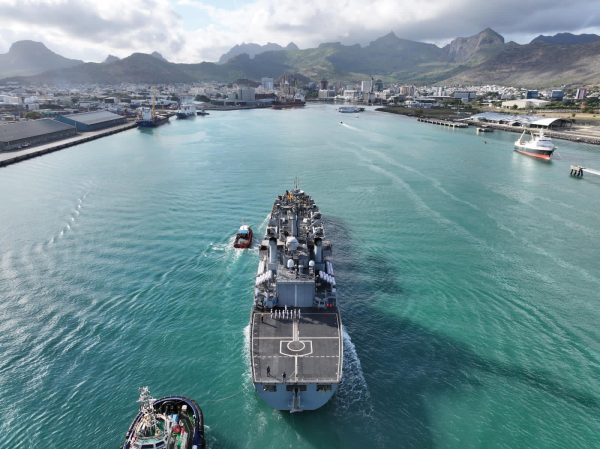By Ajai Shukla
Copyright thediplomat

Recent political developments in some Indian Ocean island nations, particularly Mauritius, are enhancing New Delhi’s leverage and prestige in the region. Last May, in accordance with a United Nations resolution that 116 nations, including India voted for, the United Kingdom (U.K.) made over to Mauritius the strategic Chagos archipelago. However, London and Washington retain joint control over Diego Garcia, one of the largest islands in the Chagos. This remains a U.S.-U.K. military base, strategically located at the center of the Indian Ocean. Meanwhile, New Delhi, which continues to follow an “anti-colonialism” policy, pressured the U.K. to withdraw its “colonial administration” from the Chagos Archipelago, restoring Mauritius’ sovereignty over the Indian Ocean island chain. Securing Chokepoints Further north in the Indian Ocean, the Indian Navy continues to secure two key choke points – the Lakshadweep and Andaman islands – through which international commercial shipping is funneled. All Pacific-bound shipping from the Persian Gulf and the Gulf of Aden converges on a 200-kilometer-wide channel called the Nine Degree Channel (named after its latitude) that India’s Lakshadweep island chain straddles. Given these islands’ strategic control over the Indian Ocean sea lanes of communication (SLOCs), India’s South-Western Naval Command established a naval base on Lakshadweep last April. After international cargo and hydrocarbon shipping transits through the Lakshadweep Islands and Sri Lanka, it enters the Bay of Bengal, 1,200 km from the Indian mainland. Here sits India’s second priceless archipelago — the Andaman and Nicobar Islands. These dominate the international SLOCs that run through them, past the 200-km-wide Six Degree Channel, before entering the Malacca Strait, the gateway to the South China Sea. Over the last two decades, India has transformed the Andamans from a military backwater into the bristling Andaman & Nicobar Command (ANC), complete with a fighter aircraft base on the so-called Car Nicobar island. In 2012, the Indian Navy inaugurated a naval air base, INS Baaz, at the very mouth of the Malacca Strait. This base, which will eventually have a 10,000-foot runway for fighter operations, takes India’s air strike power 300 km closer to the Malacca Strait than from Car Nicobar. The ANC is India’s first (and so far only) tri-service command, headed in rotation by three-star generals, admirals and air marshals, who report directly to the Integrated Defense Staff in New Delhi. The militarized Lakshadweep and Andaman islands together give India a double stranglehold over the Indian Ocean SLOCs. Iran’s bluster about shutting down the Strait of Hormuz rightly evokes skepticism, but sea power analysts mostly agree that the Indian Navy, with its flotilla of over 150 modern warships, can shut down the Indian Ocean SLOCs whenever it chooses. That would jeopardize not just the crude oil supplies of China, Japan and the ASEAN states, but also the reverse flow of exports that are crucial to these economies. All told, some 60,000 cargo vessels move through the Strait of Malacca each year, one every nine minutes. Positioning itself as the “gatekeeper to the Indian Ocean” and as the “preferred security partner” to the littoral navies, New Delhi seeks to nurture strong security ties with neighboring island nations, such as Mauritius, the Maldives, Seychelles, and Sri Lanka. The Indian Navy provides them with patrol vessels, surveillance aircraft, equipment and training, honing their abilities to monitor their respective Exclusive Economic Zones (EEZs). Joint naval exercises are conducted, with the Indian Navy providing coast guard vessels for training personnel in maritime surveillance and providing humanitarian aid and disaster relief (HADR) assistance during emergencies like the COVID-19 pandemic and the Asian tsunami in 2004. Regional countries, most notably Pakistan and China, have expressed alarm in the past at India’s “unwarranted militarization” of the Indo-Pacific. New Delhi responds that its security architecture is required to cater for a land area of 3.28 million sq km, and an additional 2.2 million sq km of “exclusive economic zone.” Passing through these waters are 90 percent of India’s trade by volume and 77 percent by value. India’s navy is the only one that operates persistently between Qatar, the forward headquarters of the United States Central Command (USCENTCOM), and the Malacca Strait, which leads on to the contested and militarized waters of the South China Sea. Need for Ships, Submarines and Air Assets New Delhi argues that its force levels are hardly excessive, being only a fraction of those of rival navies, such as China. Over the course of the year 2025-26, the Indian Navy has commissioned only five capital warships, an inadequate boost to a fleet that has taken on the responsibility of safeguarding the SLOCs, in an oceanic space through which transits more than half of all global trade. On January 15, the Indian Navy commissioned three frontline warships, all of them designed and built in India’s extensive warship building facilities — the Navy Warship Design Bureau (NWDB) and the Mazagon Dock Shipbuilders Limited (MDL), Mumbai. These included INS Nilgiri, the lead vessel of Project 17A – a class of seven stealth frigates that are being built under Project 17A at the Naval Base, Visakhapatnam. Alongside that was INS Surat, the fourth and last destroyer built under Project 15B; and INS Vagsheer, the sixth and last Scorpene-class submarine being built under Project 76. Later in the year, these three warships were followed by two more guided missile frigates of the Nilgiri-class. On August 26, Defense Minister Rajnath Singh commissioned two more guided missile frigates – INS Udaygiri and INS Himgiri. This was the first time in India’s warship-building history that two surface combatants, constructed indigenously by two different shipyards, were commissioned on the same day. INS Udaygiri has been built in Mumbai by MDL, while INS Himgiri was built in Kolkata by Garden Reach Shipbuilders & Engineers Limited (GRSE). They follow into service INS Nilgiri, the lead vessel of the seven-ship Nilgiri class. Additionally, during the current year, two Krivak III class frigates – INS Tushil and INS Tamal – have also been acquired from Russia. These are part of a contract for four frigates, of which two are to be built by Russia and the other two by an Indian shipyard.



